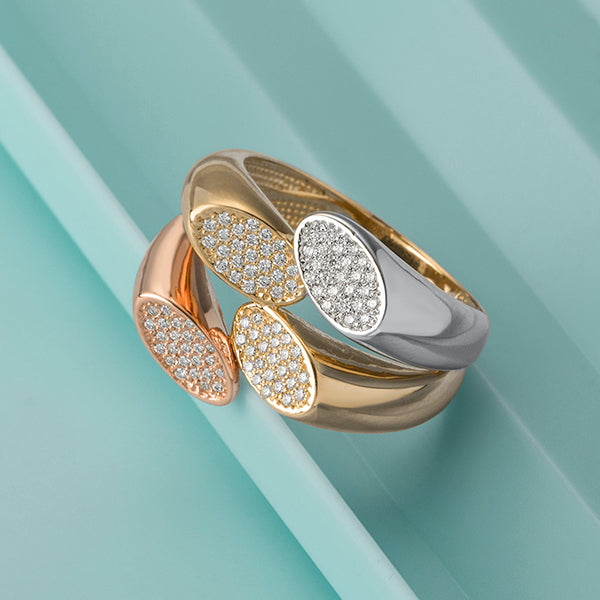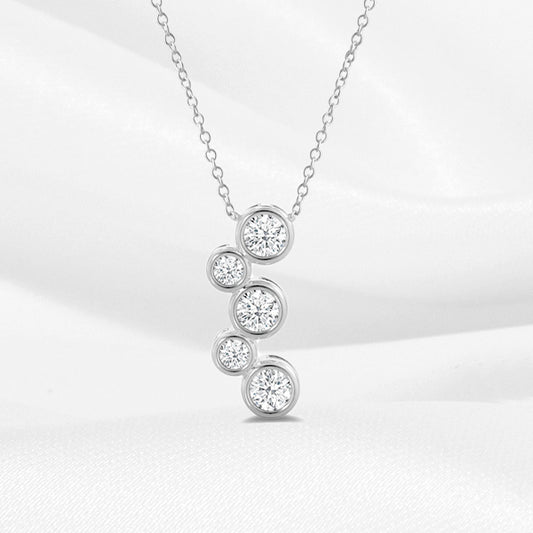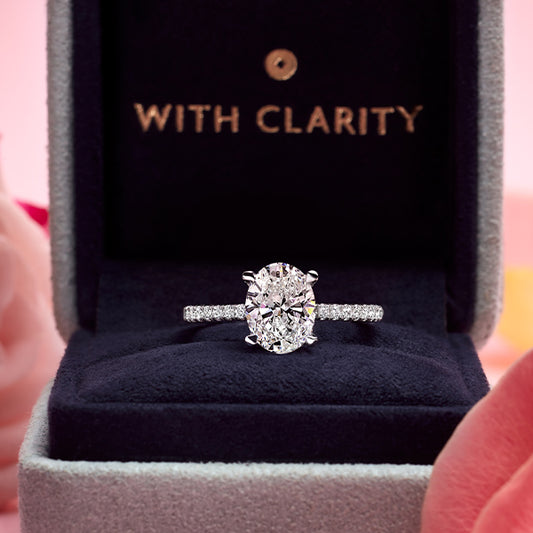Your Best Guide to Composite Diamonds

Composite diamonds may be the perfect solution if you love the look of impressive diamonds but not the price tag. What is a composite diamond, you ask? Many diamonds are painstakingly set very close together to create a cluster, often appearing as one large diamond. Sometimes, the smaller diamonds may be glued or fused, but often they're carefully set near one another. The diamonds can create an interesting pattern or unique shape depending on the placement.
But composite diamond rings aren't popular only due to their ability to look like a stunning large stone (for a fraction of the price). These creative designs are also being sought after because they have a vintage vibe that offers intricate detailing. We know it sounds too good to be true!
Well, it isn't – as long as you shop wisely. If you're considering buying a composite diamond ring or jewelry piece, our comprehensive guide can tell you everything you need to know.
What to Know About Composite Diamonds
Composite diamonds are clusters of closely set diamonds. They can vary in size (and sometimes color), but usually, they're designed to make a bunch of tiny diamonds appear as one large, dazzling stone. Composite diamonds can also be used to highlight a center stone, creating a halo or backdrop.
How are composite diamonds made? They're made using one jewelry setting and multiple smaller diamonds. In most cases, the diamonds are set very near to one another. However, they can also be glued or fused. The goal is usually to make them look like a bigger diamond, but intricate patterns can also be created. In essence, it sounds great, the aesthetic of a statement-making stone for a fraction of the typical price. But there are pros and cons.
Advantages of Composite Diamonds
- Lower cost
- A multitude of patterns and shapes are available
- Can use various gemstones to create distinctive designs
- Perfect complimentary piece to a solitaire stone
- Very versatile in terms of customization
Disadvantages of Composite Diamonds
- Uncertainty of future value due to various diamonds used
- Higher repair costs as the numerous smaller diamonds can become loose over time
It's necessary to weigh these pros and cons before buying, especially if you are considering a composite diamond engagement ring.
Types of Composite Diamonds
There are different types of composite diamonds.
- Double-composite diamonds are often called doublets and consist of two fused or set together.
- Triple-composite diamonds, referred to as a triplet, are three diamonds together.
- Multi-composite diamonds consist of either multiple diamonds set together or diamonds plus other gemstones set near one another. These diamonds can be the same size or vary.
Multi-composite stones tend to be the most popular. You can achieve a cohesive, large diamond look with many stones or create an intricate pattern.
Characteristics of Composite Diamonds
Composite diamonds can be glamorous, but there's more to consider than just their beauty.
Durability and hardness: Composite diamonds that use natural or lab-made diamonds have the same hardness as a traditional diamond ring. Diamonds rate a 10 on the Mohs scale and are one of the hardest substances found on earth. However, when multiple diamonds are set together, durability may be compromised. There are more opportunities for a stone to come loose over time. Additionally, it can be harder to inspect each diamond's small setting. Though composite diamond rings are generally hardy, they aren't considered as durable as traditionally set stones.
Clarity and color: When a composite ring is constructed, a jeweler will often choose diamonds of a similar clarity and color. Choosing like stones is important if you want your cluster of diamonds to appear as one uniform gem. Alternatively, fancy diamonds or other gemstones can be set into a composite pattern to create a one-of-a-kind design.
Brilliance and fire: Jewelers will also take into account each diamond's position and how it interacts with the light. Generally, they'll arrange them to maximize light performance, enhancing brilliance and fire. However, despite the number of diamonds in the ring, composite diamond jewelry tends to be less sparkly than one diamond set alone.
Certification and grading of composite diamonds: Most composite diamonds are small, certainly smaller than one carat. As a result, they rarely come with certification. Therefore, verifying their color, clarity, cut, and color can be challenging.
Buying Composite Diamonds
When buying composite diamond jewelry, you should consider many of the same factors as when you buy standard diamond jewelry.
First, you'll want to consider the total carat weight, which is the carat weight of all the diamonds combined. It's not crucial to find the highest TCW but to check that it is a decent weight for the price of the jewelry. Don't let TCW overshadow other factors like clarity and color. You can find a composite diamond with lots of stones, but the ring won't be as attractive if they're yellow or have poor clarity.
Next, consider the composite diamond's appearance. Are the stones of similar color and clarity? Does it sparkle or look dull? Regardless of whether you're opting for diamonds or gemstones, make sure no glass is substituted for stones. You don't have to choose only natural diamonds, though. Lab-grown diamonds or diamond alternatives like moissanite can be used and will help to lower the price even further.
Next, consider the metalwork. Ensure that you can't easily see fusing or gluing and that the design looks uniform and clean. Finally, look at the ring as a whole. Is the design appealing to you? Do you like the pattern and use of gems? Composite diamonds can range from minimalist to statement-making. Choose one that best suits your tastes.
Caring for Composite Diamond Jewelry
Caring for composite diamond jewelry isn't too complicated. Usually, dishwashing soap and warm water is advised, just like a traditional diamond. Dry it with a lint-free cloth. More buildup can occur if you have detailed patterns with many stones, so frequently check for grime and debris.
When you're not wearing your diamond jewelry, store it alone in a soft cloth bag to avoid friction against the small gems. It is a good idea to regularly inspect your jewelry to check for missing or lost stones. Finding the right stones to replace missing diamonds in composite jewelry can be difficult, so take care of your ring to minimize future stress.
Are Composite Diamonds Right for Me?
If you're looking for a show-stopping ring without spending a fortune, composite diamonds may be for you! They're also ideal for the person who wants a detailed ring with eccentric patterns and often vintage vibes. Versatile and beautiful, composite diamond jewelry makes a lovely addition to any collection.
Diamond Composite Earrings
-

Baugette & Round Diamond Composite Oval Stud Earring
starting at:$670
-

Baugette & Round Diamond Composite Round Halo Stud Earring
starting at:$950
-

Baugette & Round Diamond Composite Pear Halo Stud Earring
starting at:$980
-

Pear Decorative Basket Cluster Earring
starting at:$560
-

Round & Heart Composite Front & Back Earring
starting at:$1,440
FAQs
Is it ok to buy a composite diamond ring?
If you like the style and look, there’s nothing wrong with purchasing a composite diamond ring.
Are composite diamonds fake?
There are fake composite diamond rings using gems like cubic zirconia. However, there are also authentic composite diamond pieces that use real diamonds, either natural or manmade.
Is composite diamond worth buying?
Composite diamonds can provide a gorgeous look at a lower price point. However, they don’t hold their value as well as traditional diamond rings, making it important to weigh the pros and cons.
What are the advantages of a composite diamond ring?
A composite diamond ring can afford you a more impressive-looking stone on a budget. Also, you can achieve more unique shapes and patterns than possible with traditionally set gemstones.

